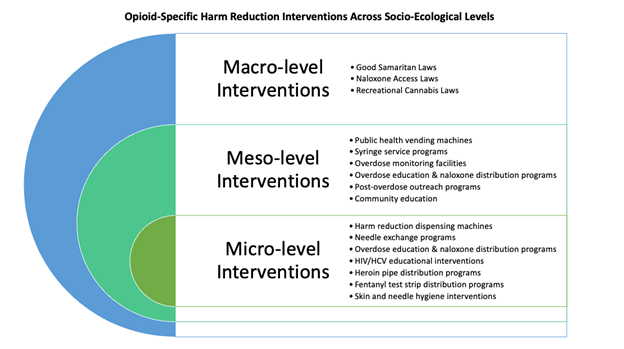By: Katie A. McCormick, MSW, Doctoral Candidate, and Dr. Kasey R. Claborn, Steve Hicks Fellow in Addiction and Recovery Services and an Assistant Professor, Steve Hicks School of Social Work, University of Texas at Austin
Opioid-involved drug overdose deaths continue to devastate the U.S., making the opioid epidemic one of the most pressing public health crises of our time (CDC, 2023).
A multitude of factors have contributed to the severity of the opioid overdose epidemic, such as opioid supply and demand, economic conditions, treatment accessibility, interpersonal stigma, and individual-level factors consistent with the bio-psycho-social model.
Numerous interventions have been implemented to address the harms of the epidemic, such as medication treatments and prescription drug monitoring programs. While these have been imperative, they fall short of reaching groups that do not engage in the traditional healthcare system due to a myriad of reasons, including the lack of accessibility and availability of services.
Harm reduction is a transformative approach that reduces drug-related harm by centering respect, individual autonomy, and pragmatism and promoting strategies that do not require abstinence (SAMHSA, 2023). Because harm reduction approaches facilitate more comprehensive service delivery, national epidemic response efforts have increasingly supported the approach.
Even though there is abundant empirical evidence demonstrating the effectiveness of harm reduction interventions, little is known about the range of harm reduction interventions that have been implemented to address the opioid epidemic in the U.S.
My colleagues and I at the University of Texas at Austin are conducting innovative work in this area. Recently published in Drugs: Education, Prevention, and Policy (January 2024), our review entitled “A Systematic Review of Macro-, Meso-, and Micro-level Harm Reduction Interventions Addressing the U.S. Opioid Overdose Epidemic” identifies and examines the outcomes of harm reduction interventions that have been implemented across socio-ecological levels to reduce opioid-related harms.
The range of interventions identified in this study is depicted in the figure accompanying this article.

We found that evidence for micro- and meso-level harm reduction interventions is largely consistent and positively associated with outcomes that reduce opioid-related harm. In contrast, evidence for macro-level interventions is mixed.
We also found that few harm reduction interventions reached Black, Hispanic, and Indigenous communities which are disproportionately impacted by the more recent waves of the opioid epidemic.
It’s plausible that experiences of discrimination, mistrust of the healthcare system, and limited access to services resulting from current and historical interpersonal and structural racism may deter these communities from utilizing harm reduction services (Godkhindi et al., 2022; Woods, 1998). Considering the overtly racist nature of historical laws and policies that criminalize drug possession and use, it’s also possible that other interventions, such as cannabis legalization or drug possession decriminalization, could mitigate opioid-related harms among Black, Hispanic, and Indigenous communities (Earp et al., 2021).
One exemplar of an equity-focused harm reduction intervention is our work creating TxCOPE, a digital platform to improve overdose data and resource distribution among communities who do not access traditional healthcare services. We used a community-engaged research approach to co-design the digital tool which engaged members of diverse communities (Claborn et al., 2022). We are currently implementing this tool across the state of Texas with the aim of promoting data-driven and equitable distribution of overdose prevention resources across communities. Learn more about TxCOPE at www.txcope.org.
Harm reduction interventions are a critical component for responding to the opioid and overdose crisis. The field of harm reduction is grounded in advancing health equity for disadvantaged communities.
SAMHSA’s (2023) Harm Reduction Framework outlines six pillars of harm reduction which include: (1) led by people who use drugs and with lived experience; (2) embraces the inherent value of people; (3) commits to deep community engagement and community building; (4) promotes equity, rights, and reparative social justice, (5) offers most accessible and noncoercive support; and (6) focuses on any positive change, as defined by the person.
As researchers and practitioners in the field of harm reduction, it is imperative that we promote health equity through culturally adapting harm reduction interventions and evaluating their effectiveness. We hope that this review will spur future research to better support our Black, Hispanic, and Indigenous communities.
---
Katie A. McCormick is a Doctoral Candidate at the Steve Hicks School of Social Work and a Research Affiliate at the Addictions Research Institute at the University of Texas at Austin. Connect with her via email at [email protected].
Dr. Kasey R. Claborn is the Steve Hicks Fellow in Addiction and Recovery Services and an Assistant Professor at the Steve Hicks School of Social Work and Department of Psychiatry at the University of Texas at Austin. Dr. Claborn is also the Director of the Addictions Research Institute and Co-Director of the South Southwest ATTC. Dr. Claborn received her Ph.D. in Clinical Psychology from Oklahoma State University. Connect with her via email at [email protected].
Centers for Disease Control and Prevention (CDC). (2023). Injuries and Violence are Leading Causes of Death. CDC
Claborn, K. R., Creech, S., Whittfield, Q., Parra-Cardona, R., Daugherty, A., & Benzer, J. (2022). Ethical by design: engaging the community to co-design a digital health ecosystem to improve overdose prevention efforts among highly vulnerable people who use drugs. Frontiers in Digital Health, 4. doi: 10.3389/fdgth.2022.880849.
Earp, B. D., Lewis, J., Hart, C. L., & with Bioethicists and Allied Professionals for Drug Policy Reform. (2021). Racial justice requires ending the war on drugs. The American Journal of Bioethics, 21(4), 4-19.
Godkhindi, P., Nussey, L., & O’Shea, T. (2022). “They’re causing more harm than good”: a qualitative study exploring racism in harm reduction through the experiences of racialized people who use drugs. Harm Reduction Journal, 19(1), 96. https://doi.org/10.1186/s12954-022-00672-y
Substance Abuse and Mental Health Services Administration. (2023). Harm Reduction Framework. Center for Substance Abuse Prevention, Substance Abuse and Mental Health Services Administration. Available here: https://www.samhsa.gov/sites/default/files/harm-reduction-framework.pdf Woods, I. P. (1998). Bringing harm reduction to the Black community. Harm reduction: